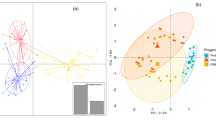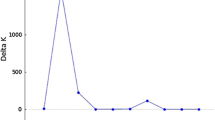Abstract
Passion fruit breeding programs often use a single fruit to obtain progeny. Open-pollination progenies are considered half-siblings since they allow the occurrence of a mixture of pollens during pollination. However, there are no studies able to prove that these progenies are, in fact, consequence of a mixture of pollens. The contribution of male genitors to the formation of open-pollinated progenies and genetic diversity were evaluated by means of microsatellite markers. A hybrid test was performed based on the gathered genotypic data, a chi-square test was used to verify the expected and observed frequencies, and the proportion of identical genes by descent (IBD) was estimated. Genetic diversity was studied through descriptive analysis, cluster analysis, and molecular analysis (AMOVA). The hybrid test indicated the participation of more than one male genitor in progeny formation. However, the genotypic composition observed in the progenies differed significantly from that expected when assuming crosses between all individuals of the origin population. The IBD values for the progenies ranged from 0.26 to 0.30, indicating that they are progenies of half-siblings. The progenies showed observed heterozygosity greater than expected and an inbreeding coefficient close to zero. The AMOVA revealed that the greatest genetic variation (81.96%) occurred within progenies. In sour passion fruit, open-pollinated progenies obtained from a single fruit do not present genotypic composition representative of their population of origin since the greatest genetic diversity was observed within the progenies.


Similar content being viewed by others
References
Akamine EK, Girolami G (1959) Pollination and fruit set in the yellow passion fruit (Technical Bulletin, 39). University of Hawaii, Hawaii Agricultural Experiment Station, Honolulu
Belo GO, Souza MM, Silva GS, Lavinscky MP (2018) Hybrids of Passiflora: P. gardneri versus P. gibertii, confirmation of paternity, morphological and cytogenetic characterization. Euphytica 214:2. https://doi.org/10.1007/s10681-017-2021-2
Benacci LC (2003) Passifloraceae. In: Wanderley MGL, Shepherd GL, Giuliett AM, Melhem IS (eds) Flora fanerogâmica do Estado de São Paulo. RiMa/FAPESP, São Paulo, pp 247–248
Botstein D, White RL, Skolmick H, Davis RW (1980) Construction of a genetic linkage map in man using restriction fragmente lenght polymorphisn. Am J Hum Genet 32:314–331
Brito GG, Caixeta ET, Gallin AP, Maciel-Zambolim E, Zambolim L, Diola V, Loureiro ME (2010) Inheritance of coffee leaf rust resistance and identification of AFLP markers linked to the resistance gene. Euphytica 173: 255–264. https://doi.org/10.1007/s10681-010-0119-x
Bruckner CH, Casali VWD, Moraes CF, Regazzi AJ, Silva EAM (1995) Self-incompatibility in passion fruit (Passiflora edulis Sims). Acta Hort 370: 45–57. https://doi.org/10.17660/ActaHortic.1995.370.7
Bruckner CH, Meletti LMM, Otoni WC, Zerbini Junior FM (2002) Maracujazeiro. In: Bruckner CH (ed) Melhoramento de fruteiras tropicais. UFV, Viçosa, pp 373–409
Bruckner CH, Suassuna TMF, Rêgo MM, Nunes ES (2005) Auto-incompatibilidade do maracujá—implicações no melhoramento genético. In: Faleiro FG, Junqueira NTV, Braga MF (eds) Maracujá: germoplasma e melhoramento genético. Embrapa Cerrados, Planaltina, pp 317–338
Caixeta ET, Ferrão LFV, Maciel-Zambolim E (2013) Marcadores moleculares. In: Borém A, Fritsche-Neto R (eds), Biotecnologia aplicada ao melhoramento de plantas, Suprema, Visconde do Rio Branco, pp 9–30
Cerqueira-Silva CBM, Jesus ON, Santos ESL, Corrêa RX, Souza AP (2014) Genetic breeding and diversity of the genus Passiflora: Progress and perspectives in molecular and genetic studies. Int J Mol Sci 15:14122–14152. https://doi.org/10.3390/ijms150814122
Cerqueira-Silva CBM, Jesus ON, Oliveira EJ, Santos ESL, Souza AP (2015) Characterization and selection of passion fruit (yellow and purple) accessions based on molecular markers and disease reactions for use in breeding programs. Euphytica 202:345–359. https://doi.org/10.1007/s10681-014-1235-9
Cruz CD (2013) GENES—a software package for analysis in experimental statistics and quantitative genetics. Acta Sci 35:271–276. https://doi.org/10.4025/actasciagron.v35i3.21251
Gomes LRP, Lopes MTG, Bentes JLD, Barros WS, Neto PDC, Contim LAS (2011) Genetic diversity in natural populations of Buriti (Mauritia flexuosa L. f.). Crop Breed Appl Biotechnol 11:216–223. https://doi.org/10.1590/S1984-70332011000300003
Martinez ML, Vukasinovic N (2000) Algoritmo para cálculo da proporção de genes idênticos por descendência, para mapear QTL em famílias de meio-irmãos. R Bras Zootec 29:443–451. https://doi.org/10.1590/S1516-35982000000200018
Matheri F, Teya F, Kioko F, Mawia AM, Mwangi M, Kirubi DT, Ngugl M, Runo S (2016) Genotyping of Kenyan Passiflora edulis flavicarpa hybrid accessions and their parents using SSR markers. Vegetos 29:1–4. https://doi.org/10.4172/2229-4473.1000181
Meletti LMM (2011) Avanços na cultura do maracujá no Brasil. Rev Bras Frutic E33:083–091. https://doi.org/10.1590/S0100-29452011000500012
Mojena R (1977) Hierarchical grouping methods and stopping rules: an evaluation. Comput J 20:359–363. https://doi.org/10.1093/comjnl/20.4.359
Moura TM, Sebbenn AM, Chaves LJ, Coelho ASG, Oliveira GCX, Kageyama PY (2009) Diversidade e estrutura genética espacial em populações fragmentadas de Solanum spp. do Cerrado, estimadas por meio de locos microssatélites. Sci For 37:143–150
Nei M (1973) Analysis of gene diversity in subdivided population. Proc Natl Acad Sci 70:3321–3323. https://doi.org/10.1073/pnas.70.12.3321
Oliveira EJ (2006) Desenvolvimento e uso de marcadores microssatélites para a construção e integração de mapas genéticos de maracujá–amarelo (Passiflora edulis Sims f. flavicarpa Deg). Tese, Universidade de São Paulo Escola Superior de Agricultura “Luiz de Queiroz”
Oliveira EJ, Pádua JG, Zucchi MI, Camargo LEA, Fungaro MHP, Vieira MLC (2005) Development and characterization of microsatellite markers from the yellow passion fruit (Passiflora edulis f. flavicarpa). Mol Ecol Notes 5:331–333. https://doi.org/10.1111/j.1471-8286.2005.00917.x
Paiva CL, Viana AP, Santos EA, Freitas JCO, Silva RNO, Oliveira EJ (2014) Genetic variability assessment in the genus Passiflora by SSR markers. Chil J Agric Res 74:355–360. https://doi.org/10.4067/S0718-58392014000300015
Pereira MG, Pereira TNS, Viana AP (2005) Marcadores moleculares aplicados ao melhoramento genético do maracujazeiro. In: Faleiro FG, Junqueira NTV, Braga MF (eds) Maracujá: germoplasma e melhoramento genético. Embrapa Cerrados, Planaltina, pp 317–338
Reis RV, Oliveira EJ, Viana AP, Pereira TNS, Pereira MG, Silva MGM (2011) Diversidade genética em seleção recorrente de maracujazeiro-amarelo detectada por marcadores microssatélites. Pesq Agropec Bras 46: 51–57. https://doi.org/10.1590/S0100-204X2011000100007
Schiestl FP, Johnson SD (2013) Pollinator-mediated evolution of floral signals. Trends Ecol Evol 28(5):307–315. https://doi.org/10.1016/j.tree.2013.01.019
Silva MM, Bruckner CH, Picanço M, Molina-Rugana AJ (1999) Número floral, clima, densidad poblacional de Xylocopa spp. (Hymenoptera: Anthophoridae) y polinización del maracuyá (Passiflora edulis f. flavicarpa). Rev Biol Trop 47(4):711–718
Siqueira KMM, Kiill LHP, Martins CF, Lemos IB, Monteiro SP, Feitoza EA (2009) Ecologia da polinização do maracujá-amarelo, na região do vale do submédio São Francisco. Rev Bras Frutic 31:001–012. https://doi.org/10.1590/S0100-29452009000100003
Souza GH (2003) Detecção de QTLs em famílias de meios-irmãos por meio de genes idênticos por descendência, utilizando simulação. Dissertação, Universidade Federal de Viçosa
Sousa NR (2001) Processos genético-evolutivos e os recursos fitogenéticos. In: Sousa NR, Souza AGC (Org.) Recursos fitogenéticos na Amazônia Ocidental: conservação, pesquisa e utilização. Embrapa Amazônia Ocidental, Manaus, pp 19–26
Suassuna TM, Bruckner CH, Carvalho R, Borém A (2003) Self-incompatibility in passion fruit: evidence of gametophytic-sporophytic control. Theor Appl Genet 106: 298–302. https://doi.org/10.1007/s00122-002-1103-1
Tomaz SR, Salgado CC, Tomé LGO, Cruz CD (2003) Detecção de QTL em populações exogâmicas. In: Cruz CD, Salgado CC, Bhering LL (eds) Genômica aplicada. Suprema, Visconde do Rio Branco, pp 169–200
Funding
This work was funded by the agencies National Council for Scientific and Technological Development (CNPq) and Coordination of Improvement of Higher Education Personnel (CAPES) and developed using the physical and personnel structure of the Federal University of Viçosa.
Author information
Authors and Affiliations
Contributions
C. H. Bruckner, C. E. M. Santos and E. T. Caixeta participated in the hypothesis elaboration, experimental planning and supervision of the manuscript writing; T. V. Sousa, R. D. S. Rosado and C. D. Cruz participated in data analysis and interpretation of results; and M. H. M. Cordeiro performed the experimental analyzes, data preparation, statistical analysis and writing of the manuscript.
Corresponding author
Ethics declarations
Conflict of interest
The authors declare that they have no conflict of interest.
Additional information
Publisher's Note
Springer Nature remains neutral with regard to jurisdictional claims in published maps and institutional affiliations.
Electronic supplementary material
Below is the link to the electronic supplementary material.
Rights and permissions
About this article
Cite this article
Cordeiro, M.H.M., Bruckner, C.H., Rosado, R.D.S. et al. Contribution of male genitors in open-pollination progenies of sour passion fruit. Euphytica 216, 147 (2020). https://doi.org/10.1007/s10681-020-02681-z
Received:
Accepted:
Published:
DOI: https://doi.org/10.1007/s10681-020-02681-z




